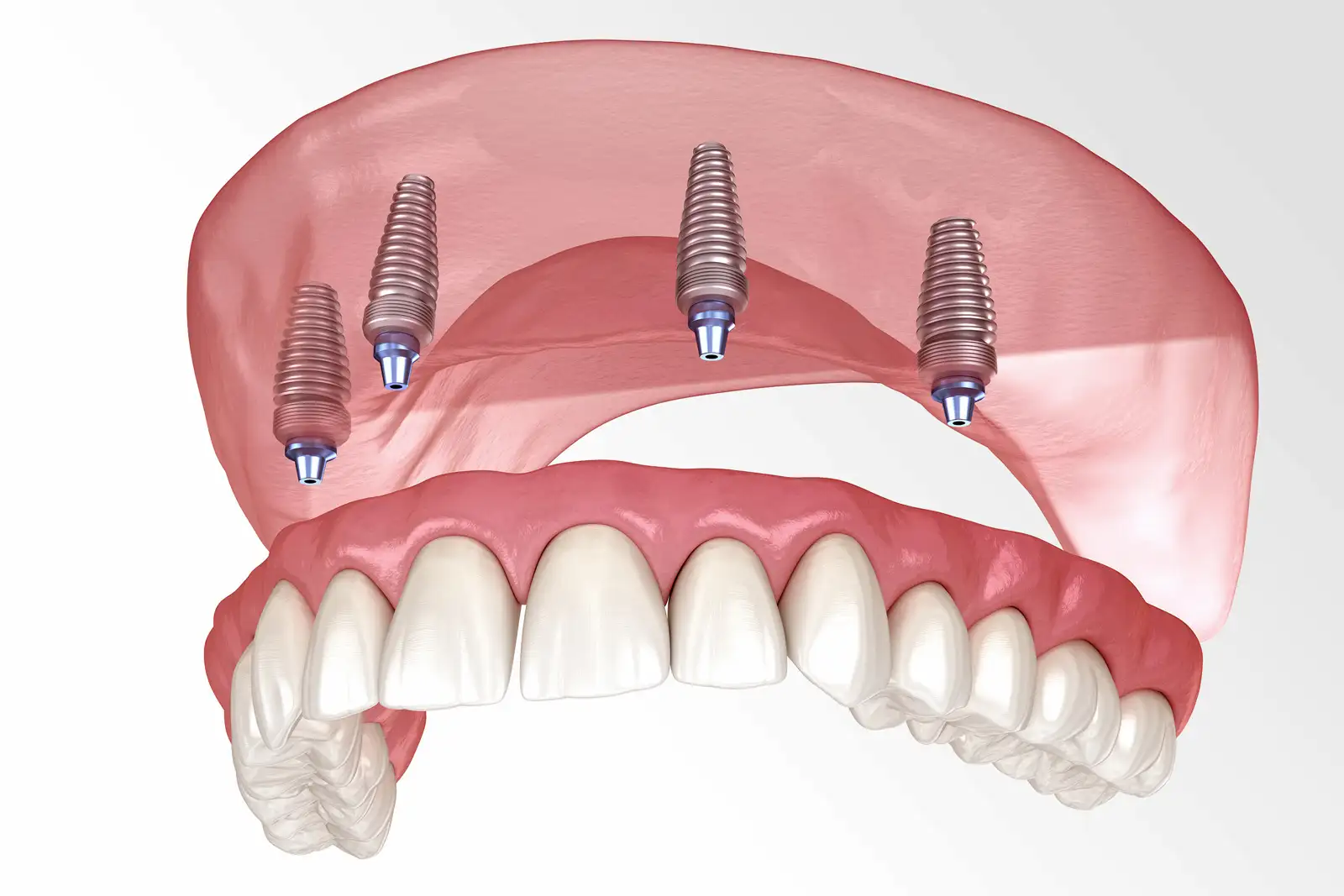Semi-fixed prosthesis on implants
For individuals who are not candidates for a fixed prosthesis but require the restoration of all teeth in one jaw, the ideal solution is a semi-fixed prosthesis on implants.

It provides an optimal combination of stability and flexibility, while allowing for a fixed attachment with the option of removal for easier maintenance of hygiene.
What is a semi-fixed prosthesis on implants?
A semi-fixed prosthesis on implants is a dental solution for patients who want a stable, functional, and aesthetically pleasing replacement for all their teeth, with the option to remove it for cleaning and hygiene maintenance.
Unlike conventional removable dentures, which rest on the gums and may move, a semi-fixed prosthesis is secured to 2 to 6 implants, determined after diagnostic evaluation in line with the treatment plan.
Implants serve as anchors to keep the prosthesis firmly in place, eliminating issues like denture slipping, discomfort while speaking, and difficulties while chewing.
Common attachment systems include:
- Locators (ball attachment) – small spherical clips on implants that connect to the prosthesis
- Bar attachment – a metal bar connects the implants and allows the prosthesis to be attached
- Telescopic crowns – a system of double crowns where the inner crown stays on the implant, and the outer one is part of the prosthesis
Advantages of a semi-fixed prosthesis on implants
- Increased stability – the prosthesis is firmly attached and does not move during speaking or eating
- Comfort – no pressure on the gums like with traditional dentures
- Aesthetic natural appearance – the prosthesis is customized to the shape and color of natural teeth
- Easier maintenance – it can be removed for cleaning, ensuring optimal hygiene
- Durability – implants provide long-lasting and stable support for the prosthesis
Who are candidates for a semi-fixed prosthesis on implants?
A semi-fixed prosthesis on implants is ideal for patients who:
- Have severely damaged teeth that cannot be treated or are edentulous
- Have reduced jawbone volume and are not candidates for fixed implant solutions
- Already wear traditional dentures but want a more stable and functional solution
- Want easier oral hygiene maintenance with the ability to remove the prosthesis
- Seek a long-lasting, aesthetically acceptable, and financially more affordable solution for full tooth replacement compared to other similar options
For successful implant placement, the patient must have enough healthy bone in the jaw. However, if there is insufficient bone, bone augmentation procedures may be performed to enable implant placement.
The process of placing a semi-fixed prosthesis on implants
The treatment is carried out in several phases to ensure maximum precision and longevity of the prosthesis. The standard procedure includes:
1. First visit – Diagnosis and planning
- Clinical examination of the oral cavity
- 3D CBCT scan of the jaw to assess bone quantity
- Selection of the optimal number of implants and prosthesis attachment system
2. Second visit – Surgical implant placement
- Placement of implants in the jaw under local anesthesia or sedation
- If necessary, additional procedures such as bone augmentation may be performed
- The patient is given a temporary prosthesis while the osseointegration process takes place
Osseointegration period (3-6 months)
- The implants fuse with the bone, providing a stable foundation for the prosthesis
- The patient uses a temporary prosthesis and follows recommended dietary and hygiene practices
3. Third visit – Placement of the semi-fixed prosthesis
- After successful osseointegration, precise impressions are taken to create the permanent prosthesis
- The prosthesis is adjusted and attached to the implants using the chosen attachment system
- Comfort, aesthetics, and functionality of the prosthesis are checked
The semi-fixed prosthesis on implants offers several advantages, such as high stability, functionality, and easy maintenance.
This method provides patients with confidence in performing daily activities without the fear of the prosthesis shifting and gives a natural tooth appearance with greater comfort compared to traditional dentures
Regular hygiene and dental check-ups are crucial for the longevity of both the implants and the prosthesis.
Frequently asked questions about semi-fixed prosthesis on implants
Typically, 2 to 6 implants are used, depending on the bone condition and desired stability of the prosthesis.
No, the procedure is performed under local anesthesia or sedation, so the patient feels no pain. Mild discomfort may occur after the procedure.
Depending on the individual case, the process can take between 3 to 6 months, including the time needed for the implants to integrate with the bone.
Yes, the patient can remove the prosthesis for cleaning, but it is securely attached and does not move during use.
Implants can last a lifetime with proper care, while the prosthesis may need to be replaced after 10-15 years due to wear.
The prosthesis is removed and cleaned with special brushes and cleaning products, while the implants are maintained with standard oral hygiene.
While not permanently fixed like a bridge on implants, it provides significantly more stability than traditional dentures.
A semi-fixed prosthesis can be removed for cleaning, while a fixed prosthesis remains permanently attached to the implants.
In some cases, it is possible to upgrade the implant system and switch to a fixed solution.
The price depends on the number of dental implants and the materials used for the prosthesis. A consultation with a dentist is recommended for an accurate estimate.
Contact us
Our friendly team will be happy to listen to your requests.
